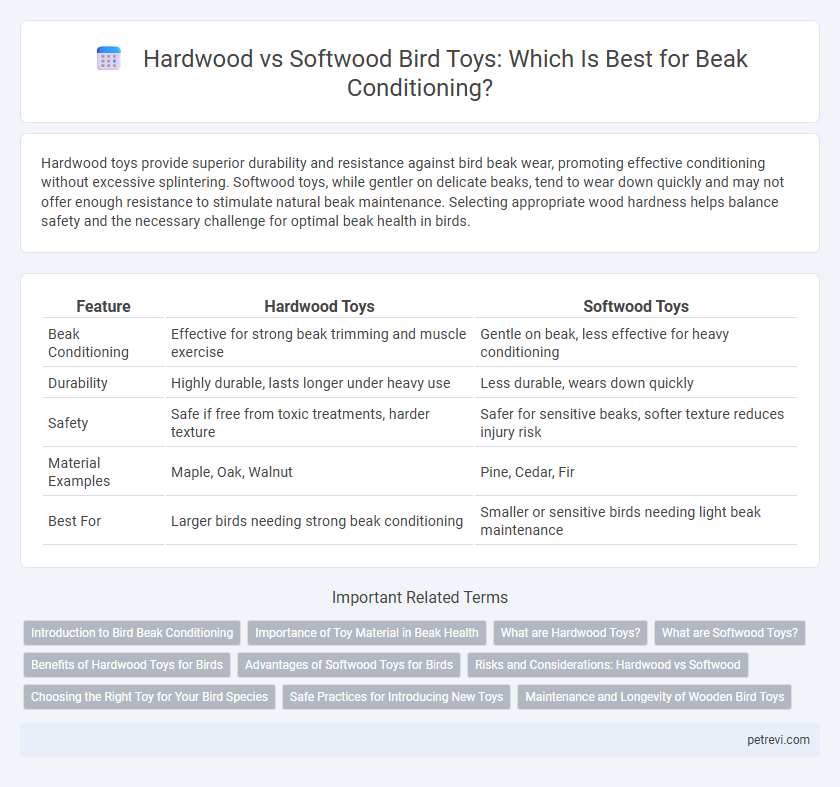Hardwood toys provide superior durability and resistance against bird beak wear, promoting effective conditioning without excessive splintering. Softwood toys, while gentler on delicate beaks, tend to wear down quickly and may not offer enough resistance to stimulate natural beak maintenance. Selecting appropriate wood hardness helps balance safety and the necessary challenge for optimal beak health in birds.
Table of Comparison
| Feature | Hardwood Toys | Softwood Toys |
|---|---|---|
| Beak Conditioning | Effective for strong beak trimming and muscle exercise | Gentle on beak, less effective for heavy conditioning |
| Durability | Highly durable, lasts longer under heavy use | Less durable, wears down quickly |
| Safety | Safe if free from toxic treatments, harder texture | Safer for sensitive beaks, softer texture reduces injury risk |
| Material Examples | Maple, Oak, Walnut | Pine, Cedar, Fir |
| Best For | Larger birds needing strong beak conditioning | Smaller or sensitive birds needing light beak maintenance |
Introduction to Bird Beak Conditioning
Bird beak conditioning involves the use of various toys to promote natural wear and maintain optimal beak health. Hardwood toys, such as those made from oak or maple, provide durable and dense material that helps effectively trim and strengthen the beak through regular chewing. Softwood toys, including pine or cedar, offer a gentler texture that encourages exploratory pecking but may not provide sufficient abrasion for long-term beak maintenance.
Importance of Toy Material in Beak Health
Hardwood toys are essential for bird beak conditioning because their dense, durable fibers provide the necessary resistance to help naturally wear down and shape beaks, preventing overgrowth and promoting overall beak health. In contrast, softwood toys tend to wear down quickly and may not offer sufficient hardness to effectively stimulate beak maintenance, potentially leading to inadequate beak trimming. Selecting toys made from untreated hardwoods like maple, oak, or birch ensures safe, long-lasting enrichment that supports the bird's natural beak shaping behavior.
What are Hardwood Toys?
Hardwood toys for bird beak conditioning are crafted from dense, durable tree species such as maple, oak, and hickory, providing a firm surface that aids in maintaining beak strength and health. These toys resist splintering, ensuring safe chewing and prolonged use, making them ideal for birds with powerful beaks like parrots and macaws. The natural texture of hardwood stimulates birds' natural foraging behavior while promoting effective beak trimming and exercise.
What are Softwood Toys?
Softwood toys for bird beak conditioning are made from trees like pine, cedar, and fir, which have a less dense, more porous structure compared to hardwoods. These toys provide a gentler texture that helps birds naturally trim their beaks while reducing the risk of damage or splintering. Softwood's lightweight and softer fibers encourage chewing and foraging behavior, promoting mental stimulation and beak health in pet birds.
Benefits of Hardwood Toys for Birds
Hardwood toys for birds provide superior durability and resistance to beak wear compared to softwood toys, promoting effective beak conditioning and preventing overgrowth. Dense hardwood materials like maple and oak offer long-lasting chewing stimulation that supports natural foraging behaviors while minimizing the risk of splinters. These benefits make hardwood toys an essential tool for maintaining optimal beak health and mental enrichment in companion birds.
Advantages of Softwood Toys for Birds
Softwood toys offer optimal beak conditioning for birds due to their softer texture, which prevents excessive wear and reduces the risk of beak damage. Species such as parrots and cockatoos benefit from the gentle resistance that softwood provides, promoting natural beak maintenance while encouraging safe chewing behavior. These toys also support mental stimulation and stress reduction without the potential hazards of splintering often associated with hardwood varieties.
Risks and Considerations: Hardwood vs Softwood
Hardwood toys for bird beak conditioning offer greater durability and resistance to wear, reducing the risk of splinters and ingestion of wood particles, which are common concerns with softer woods. Softwood toys, while often more affordable, tend to splinter easily and can cause beak damage or gastrointestinal blockages if ingested, posing significant health risks. Selecting toys made from safe, non-toxic hardwoods like maple or oak minimizes hazards and supports healthy beak maintenance without compromising bird safety.
Choosing the Right Toy for Your Bird Species
Hardwood toys are ideal for larger bird species with strong beaks, such as macaws and cockatoos, because they provide durable resistance that promotes effective beak conditioning without splintering. Softwood toys suit smaller birds like budgerigars and cockatiels, offering a gentler texture that prevents beak damage while encouraging natural chewing behavior. Selecting the appropriate toy material based on your bird's species and beak strength supports optimal beak health and mental stimulation.
Safe Practices for Introducing New Toys
Hardwood toys like maple and oak offer durable, non-toxic options that help effectively maintain bird beak health without splintering risks. Softwood toys, although gentler, may wear quickly and pose ingestion hazards if not regularly inspected for damage. Introducing new toys should involve gradual exposure and close monitoring to ensure the bird adapts safely while preventing accidental ingestion or injury.
Maintenance and Longevity of Wooden Bird Toys
Hardwood toys offer superior durability and require less frequent replacement, making them ideal for bird beak conditioning by withstanding constant chewing without splintering. Softwood toys, while often more affordable, tend to wear down quickly and may necessitate regular maintenance to prevent sharp edges that could harm the bird. Opting for hardwood bird toys ensures longer-lasting enrichment and safer beak conditioning with minimal upkeep.
Hardwood toys vs Softwood toys for Bird beak conditioning Infographic

 petrevi.com
petrevi.com